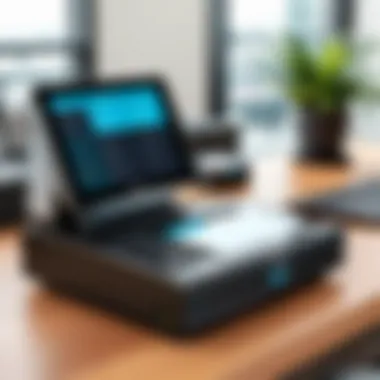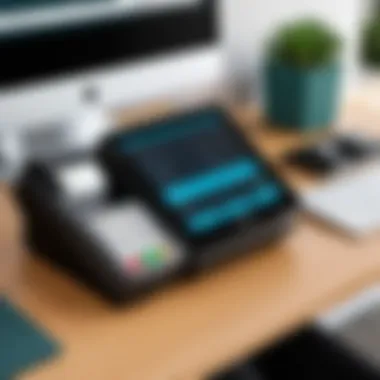In-Depth Analysis of the talech POS System


Intro
The talech POS system has emerged as a notable contender in the point-of-sale landscape. As businesses increasingly seek streamlined and efficient operations, understanding the intricacies of various POS systems becomes essential. This analysis aims to explore the talech POS's core features, user experience, and cost structure. By providing a detailed breakdown, it targets business decision-makers who need to assess where talech stands in relation to other solutions.
Key Features
Overview of Features
talech POS system offers a suite of functionalities designed to cater to diverse business needs. The system provides powerful tools for processing transactions, managing inventory, and analyzing sales data. It enables businesses to accept various payment methods including credit cards, digital wallets, and other electronic payments, offering flexibility to customers during checkout.
Inventory management stands out as a key component. Businesses can track stock levels in real-time, set alerts for low inventory, and generate detailed reports that inform purchasing decisions. Additionally, talech supports customer relationship management (CRM), allowing users to build and maintain customer profiles, track purchase histories, and manage loyalty programs to enhance customer engagement.
Unique Selling Propositions
the talech POS system boasts several unique selling propositions that differentiate it from competitors. Its user-centric interface is intuitive and designed to minimize the learning curve for new users. This ease of use is particularly appealing for smaller businesses or those with less technical expertise.
The integration capabilities with existing software solutions are another highlight. talech can connect seamlessly with accounting software, eCommerce platforms, and staffing solutions, making it a versatile choice for a variety of operational contexts. Additionally, the mobile POS functionality allows businesses to process transactions on-the-go, which is increasingly important in today’s retail environment.
Pricing Models
Different Pricing Tiers
talech offers a range of pricing tiers, catering to businesses of different sizes and needs. The primary structure typically includes monthly subscription plans, which may vary based on features and services included. More advanced options, such as additional reporting tools or premium integrations, may incur higher fees. Understanding these tiers is crucial as they directly impact budget allocation for technology solutions.
ROI and Cost-Benefit Analysis
When evaluating a new POS system, return on investment (ROI) and cost-benefit analyses serve as essential components of the decision-making process. talech aims to provide an efficient system that can improve transaction speed and accuracy, thus reducing operational costs over time. Users often report significant time savings on inventory management and reporting processes, which enhances overall productivity.
A thorough analysis should consider the initial setup costs against the benefits gained through improved sales operations. As such, placing talech’s features and benefits in context can illuminate its value proposition.
"The ease of use and comprehensive features of talech have streamlined our operations significantly. The integration with other systems has been invaluable for our growth strategy."
— A satisfied talech POS user
In summary, this analysis of the talech POS system underscores its functionalities and relevance in modern business environments, while also providing insights into pricing and profitability. It equips decision-makers with the necessary information to assess whether talech aligns with their specific operational needs.
Intro to talech POS System
The talech POS system is becoming a significant player in the point-of-sale industry. Understanding how it integrates into different business processes is crucial for decision-makers. This section serves as a gateway to dissecting the nuances of talech and its functionalities. The importance lies in its design to improve sales operations, customer interactions, and overall business efficiency.
Overview of POS Systems
Point-of-sale (POS) systems are essential tools for the retail and hospitality industries. They facilitate transactions, manage inventory, and track sales data, allowing businesses to operate smoothly. A typical POS system integrates hardware and software to streamline various aspects of business operations.
POS systems address multiple aspects, including:
- Transaction Processing: This core function enables businesses to conduct sales and process payments efficiently.
- Inventory Management: Businesses can track stock levels, reorder supplies and minimize shortages.
- Customer Insights: By collecting data on customer purchasing behaviors, businesses can enhance customer relationships and tailor their marketing strategies.
As the market evolves, businesses are looking for more sophisticated systems to meet their needs. The talech POS system addresses these requirements effectively by combining several functionalities within a single platform.
Preamble to talech
Talech began as a solution focused on simplifying the complexities of retail management. It offers a user-friendly interface that appeals to both tech-savvy individuals and those less familiar with technology. The emphasis on usability sets talech apart in a crowded market.
Key elements of talech include:
- Cloud-Based System: This allows real-time access to information from any location, facilitating remote management.
- Multi-Device Compatibility: Whether using tablets, smartphones, or traditional registers, talech adapts seamlessly to various hardware configurations.
- Customization Options: Businesses can tailor the system to their specific operational needs, offering flexibility in how they manage sales and customer relations.
As competition intensifies among POS providers, the talech POS system represents a robust solution that balances simplicity with comprehensive features. Its effectiveness in catering to the needs of modern businesses positions it as a valuable asset for those looking to increase productivity and gain insights into their operations.
"A strong POS system like talech can significantly enhance a business’s efficiency, ultimately leading to higher customer satisfaction and increased revenue."
Investing in the talech system equips businesses with the necessary tools to thrive in a competitive landscape. It is an essential framework to delve deeper into in the later sections of this article.


Core Features of talech
The Core Features of talech POS system provide essential tools that cater to the diverse needs of businesses. Recognizing the dynamic landscape of retail and service industries, talech presents functionalities that are tailored to improve operational efficiency, enhance customer engagement, and provide reliable financial management. Each feature contributes not only to boosting productivity but also to establishing a seamless workflow that can adapt to various business contexts.
Sales and Inventory Management
Sales and inventory management is one of the cornerstones of the talech POS system. Effective management of sales data and stock levels is critical for any business. talech offers a user-friendly interface that simplifies the tracking of inventory. Users can easily monitor stock levels in real-time, set alerts for low inventory, and automate reordering processes.
Key elements include:
- Product Variants: Businesses can manage product attributes such as sizes and colors without complexity.
- Sales Tracking: Detailed reports help to analyze sales trends over time, identifying peak sales periods and slow-moving stock.
- Integrated Inventory Management: This feature syncs with sales data to ensure that inventory counts are accurate, reducing discrepancies.
These tools enable businesses to make informed decisions about purchasing and sales strategies.
Customer Relationship Management
Another vital aspect of the talech system is its customer relationship management (CRM) functionalities. This feature aims to foster long-term relationships between businesses and their customers. By capturing customer data at the point of sale, businesses can gain insights into buying behaviors.
Notable features include:
- Customer Profiles: Store detailed profiles that include purchase history and preferences.
- Loyalty Programs: Easily implement rewards and loyalty incentives that cater to returning customers.
- Targeted Marketing: Leverage customer data for personalized promotions, effectively increasing sales opportunities.
With this feature, companies can enhance their marketing efforts and build a loyal customer base.
Reporting and Analytics Tools
Reporting and analytics tools within talech offer crucial insights into business performance. These functionalities empower business leaders by providing clear metrics to base their decisions on. Users can generate customizable reports ranging from daily sales summaries to quarterly financial forecasts.
Essential components include:
- Data Visualization: Graphical representations of data make complex information easier to understand.
- Trend Analysis: Identify patterns and trends in sales data to optimize inventory and pricing strategies.
- Performance Metrics: Access key performance indicators (KPIs) that reflect the overall health of the business.
This systematic approach supports strategic planning and operational improvement.
Payment Processing Capabilities
The payment processing capabilities of talech are designed to be robust and flexible. As payment methods evolve, businesses need to offer a variety of options to meet customer expectations. talech supports multiple payment types, including credit and debit cards, digital wallets, and cash transactions.
Key features involve:
- Secure Transactions: High-level encryption protects transaction data, ensuring customer information remains safe.
- Quick Checkout Process: Streamlined payment processes reduce waiting times, enhancing customer satisfaction.
- Integration with Payment Providers: Users can connect various payment gateways easily, offering versatility in transaction management.
These capabilities enhance the overall customer experience, promoting seamless and secure purchasing.
The core features of talech POS system not only drive sales but also enhance customer experiences through sophisticated CRM and payment solutions.
Usability and User Experience
Usability and user experience are crucial elements when evaluating a point-of-sale system like talech. They directly influence how effectively staff can interact with the system and how smoothly transactions proceed. A well-designed user interface can lead to a shorter training time for employees and increased customer satisfaction. Businesses want their staff to focus on service rather than struggling with complicated software. Additionally, a good user experience can drive efficiency, maximizing the overall productivity of the operational setup.
Interface Design and Navigation
The interface of talech is designed with simplicity and functionality in mind. The dashboard provides an organized layout that allows users to access key features without unnecessary clicks. Main functions are easily visible, ensuring that users can navigate quickly to sales, inventory, and reporting sections. This is essential for fast-paced environments where every second counts.
Furthermore, the system utilizes a touch-friendly interface suitable for tablet devices, as the majority of transactions occur on screens. A clear labeling of buttons and functionalities reduces confusion.
Some of the notable aspects of talech’s interface design include:
- Intuitive Layout: Users can find what they need without extensive training.
- Customizable Menus: Allows businesses to tailor the interface to their specific needs.
- Responsive Design: Ensures that the system performs well on different devices.
Overall, the navigation structure supports effective task completion. Less time spent searching for options leads to enhanced service delivery.


Ease of Setup and Configuration
Setting up the talech POS system is generally straightforward. The installation process is designed to ensure that users can quickly get the system up and running. This is especially important for businesses that want minimal downtime during transition periods.
The initial configuration includes linking hardware components such as cash drawers, barcode scanners, and receipt printers. Additionally, talech provides guided tutorials that allow users to understand how to set up the software step by step.
Key features related to ease of setup include:
- Guided Installation: Offers clear directions to install and configure the system.
- Cloud-Based Storage: Reduces the need for local servers, simplifying data management and accessibility.
- Comprehensive Support: Access to customer support ensures that issues can be resolved swiftly.
Integration Capabilities
Integration capabilities of a POS system like talech are critical for modern businesses. They ensure that various software solutions can work together seamlessly. This is important to streamline operations and enhance efficiency. Businesses often utilize multiple software programs for different functions. Having a POS system that integrates well means that data can flow smoothly between these systems. This integration reduces manual work, helps maintain accurate data, and improves overall productivity.
Compatibility with Other Software
The talech POS system is known for its flexibility. It is compatible with various software solutions often used in retail and hospitality industries. These include inventory management systems, accounting software, and e-commerce platforms. For instance, talech can integrate with accounting tools like QuickBooks and Xero. This allows businesses to manage financial transactions more effectively by connecting sales data directly to their accounting records.
Utilizing an integrated system means businesses do not need to enter data manually into separate software. This saves time and minimizes errors. Furthermore, compatibility with customer relationship management (CRM) systems can enhance customer interactions. By connecting talech with a CRM system, businesses can gain insights into customer purchasing behavior. This information helps in designing better marketing strategies.
Some key considerations for integration include:
- Ease of Use: User-friendly design is important for smooth transitions between integrations.
- Cost: Some integration solutions might incur additional costs.
- Support: Availability of technical support for integrations ensures businesses can resolve issues quickly.
Third-Party Application Support
Support for third-party applications is another essential feature of the talech POS system. This allows users to expand functionality by incorporating other applications. Businesses can leverage a wide range of tools tailored to their specific needs. For example, talech supports various payment processors beyond its core capabilities. Users can choose processors that may offer better rates or specific features that best fit their operations.
Moreover, talech allows integration with loyalty programs and marketing tools. This feature can be beneficial for businesses that want to enhance customer loyalty. Managing these applications through talech’s platform means all vital data is accessible in one place. Therefore, decisions based on comprehensive data can be made.
"Effective integration with third-party apps maximizes the investment in the POS system."
The benefits of third-party application support are numerous:
- Tailored Solutions: Businesses can select applications that meet their unique requirements.
- Scalability: As a business grows, it can add new applications without replacing the existing POS system.
- Innovation: Users can access the latest technologies and tools, keeping their operations current.
In summary, the integration capabilities of the talech POS system offer significant advantages. Businesses can enjoy streamlined operations, reduced errors, and better decision-making through effective integration with other software and support for third-party applications.
Pricing Structure
Understanding the pricing structure of the talech POS system is vital for any business evaluating its potential investment. This section elaborates on how the pricing model impacts the overall value for businesses and ensures alignment with their operational expenses and budget projections. A clear pricing structure can enhance financial predictability and support informed decision-making. Moreover, a deep dive into the costs can uncover hidden fees or unexpected charges that could impact a company's bottom line.
Subscription Plans and Costs
The talech POS system primarily operates on a subscription basis. Businesses can choose from various plans, each tailored to meet different needs. Typically, the monthly subscription fees cover software updates, customer support, and cloud storage.
The core subscription tiers usually include:
- Basic Plan: Offers essential POS features suitable for small businesses. Suitable for those who need basic sales functionalities without advanced features. Cost generally is around $50 per month.
- Standard Plan: Suitable for medium-sized businesses, includes additional features like advanced analytics. Costs approximately $100 monthly.
- Premium Plan: Offers all features, including sophisticated reporting and customer management tools. It often starts around $150 a month.
It is essential for potential users to analyze their business needs against these plans to find the best fit. Additionally, users should inquire about any annual payment discounts which might lower costs significantly.
Additional Fees and Costs
While subscription fees are clear, additional costs can surprise users. It's important to be aware of potential extra charges that might arise, impacting the estimated expenses associated with the talech POS.
Common additional fees might include:
- Transaction Fees: These fees are often applicable when processing credit card payments. Users should check if these are included in their subscription or billed separately.
- Hardware Costs: Investing in POS hardware can add to initial costs. Talech is often compatible with devices that may need to be purchased separately, such as barcode scanners or receipt printers.
- Setup Fees: Some businesses might incur one-time setup fees for installation and customization of the POS system.
To make the most informed decisions, companies should thoroughly review the contract for any stated fees and conditions. A comprehensive understanding of the total cost of ownership will prevent any shocks to the budget down the line.


"A clear view on pricing structure ensures businesses can plan their financials without surprise expenses."
By examining both subscription plans and any additional costs, businesses will be in a stronger position to leverage the talech POS system effectively.
Comparative Analysis
In the world of point-of-sale systems, making informed decisions is crucial for business leaders. Comparative analysis helps in this regard by providing a structured way to evaluate different solutions against each other. This section focuses on the competitive positioning of talech against other notable players in the market, specifically Competitor A and Competitor B. Breaking down aspects like features, usability, and cost-effectiveness can help businesses find the right fit for their operational needs.
By assessing talech alongside its competitors, decision-makers can identify strengths and weaknesses that may not be obvious from a single perspective. It’s important to consider not just features, but also how these features translate into real-world usability and value. Such insights are essential for any enterprise looking to optimize their operations.
talech vs. Competitor A
When comparing talech to Competitor A, the differences in user experience and feature sets become apparent.
Competitor A might boast an extensive range of features, but how they are implemented is what truly matters. Talech focuses on simplicity and intuitive design. For example, while Competitor A might require extensive training to get staff accustomed to the system, talech has user-friendly interfaces that are easy to navigate.
Businesses often mention the following points when comparing the two:
- User Interface: talech tends to have a cleaner and more modern look, making transactions quicker and smoother.
- Customer Service: Customer feedback often highlights talech's accessible customer support, which can be a deciding factor when system malfunctions occur.
- Integration: Talech can connect more seamlessly with other software, reducing potential issues during transitions.
Overall, while Competitor A may offer a broader feature list, talech shines in its execution and ease of use.
talech vs. Competitor B
Comparing talech with Competitor B also yields interesting insights. Competitor B is known for its high levels of customization. However, this can make it less accessible for smaller businesses. Talech, on the other hand, provides a good balance between essential customization and usability.
When looking at specific aspects, consider these key takeaways:
- Pricing Structure: Talech presents clearer pricing, which can help businesses calculate their costs more accurately, while Competitor B has hidden fees that can surprise users later.
- Feature Set: Although Competitor B offers various advanced features, many users find that they do not utilize most of them, making talech a more sensible choice.
- Installation and Training: Talech’s setup is quicker, and staff need less time to learn to use the system effectively.
"Choosing the right POS system isn't about having the most features, it's about having the right features that enhance efficiency."
By understanding the competitive landscape, businesses can make more informed choices that best suit their needs.
Customer Feedback and Testimonials
Understanding customer feedback and testimonials is crucial for evaluating the talech POS system. This segment provides insights from actual users and case studies that highlight the system's strengths and potential areas for improvement. In today’s competitive landscape, qualitative data from user experiences can guide business decision-makers in their software selections. Evaluating feedback helps organizations grasp the efficiency, usability, and overall satisfaction associated with the talech POS system.
Summary of User Reviews
User reviews give a clear picture of the talech POS system performance in real-world scenarios. Many reviews commend its intuitive interface, which allows quick training for staff. A common sentiment is that it streamlines operations, especially in busy retail environments. Users have noted that features like customer management and inventory control have enabled them to operate more effectively.
However, not all feedback is positive. Some users have reported issues with customer support responses, particularly in times of system outages or when needing technical assistance. This insight is valuable for potential buyers considering talech as their POS solution.
- Positive feedback points:
- Negative feedback points:
- Easy-to-navigate interface
- Effective sales tracking
- Enhanced customer relationship tools
- Respond times from customer support
- Occasional bugs during transactions
Case Studies from Businesses
Several case studies illustrate the impact of using the talech POS system across diverse sectors. For instance, a small boutique located in a vibrant urban area implemented talech to manage its increasing inventory and improve sales analytics. The owners reported a 30% increase in operational efficiency within three months of adoption. The system enabled better insight into sales patterns, which informed purchasing decisions.
A restaurant in a busy metropolitan location adopted talech to enhance their customer relationship management. They experienced significant improvements in handling reservations and managing customer orders. Post-adoption, customer retention rates saw an uptick, highlighting the system’s efficacy in fostering loyalty through improved service.
!> "Implementing the talech POS system was pivotal for our business growth. The insights we gained from daily reports changed how we manage inventory and customer relations." - Owner of a boutique
These case studies reflect how the talech POS system can be integrated into various business models. Each experience contributes to a larger understanding of how the system caters to specific industry needs.
Finale
In discussing the talech POS system, it becomes crucial to synthesize the diverse elements covered throughout the article. The conclusion serves as an essential recap of the observations made regarding the features, usability, integration capabilities, pricing structure, and comparative analysis against other systems enabled in the market.
The talech POS system stands out due to its comprehensive functionality, which aligns closely with the operational needs of various businesses. It integrates essential sales and inventory management tools alongside customer relationship management features, providing robust support to decision-makers. A noteworthy point is talech's intuitive interface, which simplifies user engagement and reduces the learning curve significantly.
Moreover, the pricing structure of talech is tailored to organizations of different sizes, allowing flexibility that many competitors lack. This adaptability can be an influential factor when businesses weigh their options for POS solutions. The support for integrations with various third-party applications also enhances the system's versatility in existing business environments.
"A well-thought-out conclusion not only wraps up an article but also emphasizes the core messages that should resonate with the audience."
By reviewing customer feedback, including summaries of reviews and case studies from actual users, the conclusion encourages potential users to reflect on the system's demonstrated effectiveness. Thus, this analysis not only reveals talech's strengths but also provides a pathway for informed decision-making among business leaders. In a landscape where operational excellence is key, understanding the implications of adopting a POS system like talech is invaluable.















